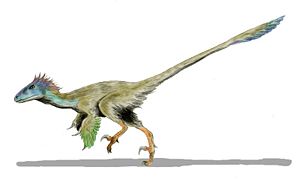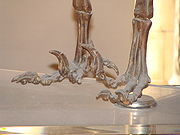- Dromaeosaurinae
-
Dieser Artikel wurde aufgrund von formalen und/oder inhaltlichen Mängeln in der Qualitätssicherung Biologie zur Verbesserung eingetragen. Dies geschieht, um die Qualität der Biologie-Artikel auf ein akzeptables Niveau zu bringen. Bitte hilf mit, diesen Artikel zu verbessern! Artikel, die nicht signifikant verbessert werden, können gegebenenfalls gelöscht werden.
Lies dazu auch die näheren Informationen in den Mindestanforderungen an Kurzartikel der Biologie.
Dromaeosauridae 
Utahraptor ostrommaysorum, ein Dromaeosaurier aus der Unterkreide Nordamerikas
Zeitraum Mitteljura (Bathonium) bis Oberkreide (Maastrichtium) 167 bis 65,5 Mio. Jahre Fundorte - Nordamerika, Südamerika
- China, Mongolei, Japan
- Europa, Nordafrika, Madagaskar
- Argentinien, Antarktis
Systematik Dinosaurier (Dinosauria) Echsenbeckendinosaurier (Saurischia) Theropoden (Theropoda) Coelurosauria Deinonychosauria Wissenschaftlicher Name Dromaeosauridae Matthews & Brown, 1922 Die Dromaeosauridae sind eine Gruppe kleiner bis mittelgroßer, fleischfressender Dinosaurier aus der Kreidezeit. Sie waren wahrscheinlich befiedert und gelten als Verwandte der Vögel (Aves). Der Name Dromaeosauridae bedeutet Laufende Echse (Gr.: dromeus = Läufer, sauros = Echse. In der Populärkultur werden sie, bekannt geworden durch Velociraptor in dem Film Jurassic Park, als Raptoren bezeichnet.
Fossilien der Tiere wurden in Nordamerika, Europa, Nordafrika, Madagaskar, Japan, China, der Mongolei, Argentinien und der Antarktis gefunden [1]
Sie lebten etwa 100 Millionen Jahre, erschienen zuerst im Mitteljura (Bathonium) vor 167 Millionen Jahren und lebten bis zur Kreide-Tertiär-Grenze vor 65,5 Millionen Jahren. Die Existenz dieser Gruppe im Mittleren Jura ist durch den Fund von isolierten Zähnen aus dieser zeit bestätigt worden [2].
Systematik
- Dromaeosauridae
- Atrociraptor
- Dromaeosauroides
- Luanchuanraptor
- Mahakala
- Pyroraptor
- ?Unquillosaurus [3]
- Variraptor
- Unterfamilie Dromaeosaurinae [4]
- Unterfamilie Microraptorinae [5]
- Bambiraptor
- Cryptovolans [6]
- Graciliraptor
- Microraptor
- Sinornithosaurus
- Unterfamilie Unenlagiinae [7]
- Austroraptor [8]
- Buitreraptor
- Neuquenraptor
- Rahonavis
- Shanag
- Unenlagia
- Unterfamilie Velociraptorinae [9]
- Deinonychus
- Nuthetes [10]
- Saurornitholestes
- Tsaagan
- Velociraptor
Einzelnachweise
- ↑ Case, J.A., Martin, J.E., & Reguero, M. (2007): A dromaeosaur from the Maastrichtian of James Ross Island and the Late Cretaceous Antarctic dinosaur fauna. Pp. 1-4 in Cooper, A., Raymond, C., & Team, I.E. (eds.), Antarctica: a Keystone in a Changing World -- Online Proceedings for the Tenth International Symposium on Antarctic Earth Sciences, U.S. Geological Survey Open-File Report 2007-1047, SRP 083. U.S. Geological Survey, Washington, D.C.
- ↑ Metcalf, S.J., Vaughan, R.F., Benton, M.J., Cole, J., Simms, M.J. and Dartnall, D.L.: A new Bathonian (Middle Jurassic) microvertebrate site, within the Chipping Norton Limestone Formation at Hornsleaslow Quarry, Gloucestershire. In: Proceedings of the Geologists’ Association. 103, 1992, S. 321–342
- ↑ Novas and Agnolin, (2004). Unquillosaurus ceibalii Powell, a giant maniraptoran (Dinosauria, Theropoda) from the Late Cretaceous of Argentina. Rev. Mus. Argentino Cienc. Nat., n.s. 6 (1): 61-66.
- ↑ Matthew, W. D., & Brown, B. (1922): he family Deinodontidae, with notice of a new genus from the Cretaceous of Alberta. Bulletin of the American Museum of Natural History, 46: 367-385.
- ↑ Senter, Phil, Barsbold, R., Britt, Brooks B. & Burnham, David B. (2004): Systematics and evolution of Dromaeosauridae (Dinosauria, Theropoda). Bulletin of the Gunma Museum of Natural History 8: 1–20.
- ↑ Czerkas, S.A., Zhang, D., Li, J., & Li, Y. (2002): Flying Dromaeosaurs. in Czerkas, S.J.. Feathered Dinosaurs and the Origin of Flight: The Dinosaur Museum Journal 1. Blanding: The Dinosaur Museum. pp. 16–26 [1]
- ↑ Bonaparte, (1999).
- ↑ F. E. Novas, D. Pol, J. I. Canale, J. D. Porfiri & J.O. Calvo: A bizarre Cretaceous theropod dinosaur from Patagonia and the evolution of Gondwanan dromaeosaurids. Proc. R. Soc. B doi:10.1098/rspb.2008.1554
- ↑ Barsbold, R. (1983). O ptichikh chertakh v stroyenii khishchnykh dinozavrov. ["Avian" features in the morphology of predatory dinosaurs]. Transactions of the Joint Soviet Mongolian Paleontological Expedition 24: 96-103. [Original article in Russian.] Translated by W. Robert Welsh, copy provided by Kenneth Carpenter and converted by Matthew Carrano. PDF fulltext
- ↑ Sweetman, S.C. (2004). The first record of velociraptorine dinosaurs (Saurischia, Theropoda) from the Wealden (Early Cretaceous, Barremian) of southern England. Cretaceous Research, 25(3): 353-364. doi::10.1016/j.cretres.2004.01.004
Weblinks
Wikimedia Foundation.

